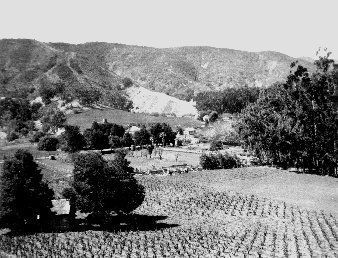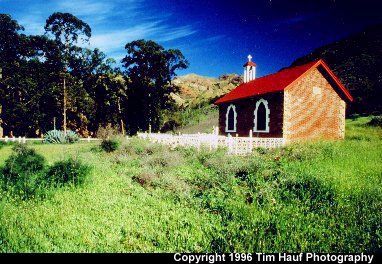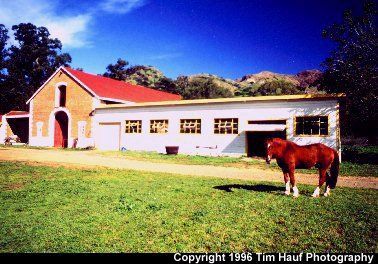Santa Cruz Island
"The Channel Islands are part of the parish of San Buenaventura Mission, Ventura, California."
At the request of Msgr. Francis J. Weber, Pastor of San Buenaventura Mission (1975-1981), Cardinal Timothy Manning, Archbishop of Los Angeles (1970-1985), with the consent of his Board of Consulters, officially decreed on March 19, 1976, "The Channel Islands are part of the parish of San Buenaventura Mission, Ventura, California."
The Catholic history of the islands, San Miguel, Santa Rosa, Santa Cruz, and Anacapa, dates from provincial times. In 1805 there were 10 rancherias on Santa Cruz and several villages on Santa Rosa. Fray Estevan Tapis considered establishing a mission on Santa Cruz to accommodate the families. At present, the only church on Santa Cruz Island is now privately owned. Mass has been celebrated in the chapel built in 1891 on an irregular basis for over a century.
In 1967 Msgr. Weber first contacted Mr. Carey Stanton about visiting Santa Cruz Island. Permission was granted provided that Mass be celebrated in Latin and so it was on May 3, 1968. The Santa Cruz Island Foundation currently holds Mass at the chapel each May 3rd, the Feast of the Holy Cross (Santa Cruz).
The following information is taken from the Santa Cruz Island Foundation website:
Santa Cruz Island has an Indian history dating back over 10,000 years. The Indians called the island, Limu. The University of California, Santa Barbara estimated that there are as many as 3000 sites or middens on the island although many are considered to have been temporary. The Indian occupants of the island were skilled mariners who traded with the other Channel Islands as well as the mainland villages.
The history of European man on Santa Cruz Island began on October 13, 1542 with the arrival of explorer Juan Rodriguez Cabrillo. Journal of his expedition indicate that although Santa Cruz Island was sighted, no one is known to have landed upon the island. During the next two and a half centuries, at least four separate expeditions visited Santa Cruz Island.
The 1769 expedition led by Gaspar de Portola for the King of Spain was the first to claim ownership of the island. The expedition was divided into two parts: the land expedition led by Portola and Fray Junipero Serra, and the sea going exploration led by Juan Perez. On board ship with Juan Perez was a Franciscan priest. At a place now called Prisoner's Cove the priest is said to have gone ashore and to have forgotten his walking staff which was topped with an iron cross.
The staff, given up for lost, was returned the next day to the priest by some Indians. From this incident the island is said to have been named, Isla de Santa Cruz--Island of the Holy Cross.
During Spain's ownership of Santa Cruz Island, Chumash Indians continued to live on the island, though in decreasing numbers. By 1807 however, measles had spread among the Indians, greatly reducing their numbers. By 1814 the majority of the island Chumash had been removed to the mainland.
The Mexican Era in California began in 1822 with the belated notice of the independence of Mexico from Spain in 1821. In 1839, Governor Alvarado of California conveyed to Andres Castillero the Island of Santa Cruz. With this grant, Castillero became the first private owner of Santa Cruz Island, a position he was to hold for 18 years. During Castillero's tenure the island became one of the most admired sheep ranches in California.
In 1848, the Treaty of Guadalupe Hidalgo ended the Mexican War and after a long legal battle the U.S. Supreme Court confirmed Castillero to be the rightful owner. In 1857, Castillero sold the +island to William E. Barron of San Francisco who continued the ranching enterprise begun by Castillero.
In 1869, Barron sold the island to ten men from San Francisco who formed the Santa Cruz Island Company. One of these men, Justinian Caire, was to emerge as Santa Cruz Island's sculptor of the future.
The Caire years:

Justinian Caire was born in France in 1827. He came to California in 1851 and established a successful hardware business in San Francisco.
With the success of his business he was able to diversify his investments and by 1880 had acquired all the stock in the Santa Cruz Island Company. In that same year, Caire arrived for the first time to the island.
Under Caire's direction, buildings including ranch houses, bunk houses, barns, wineries, a chapel, blacksmith shop and saddle shop were constructed. Full time employees included masons, carpenters, painters, vaqueros, dairymen, a wagon maker, vintners, sheep shearers and a sea captain and sailors to run the Company's 60 foot schooner Santa Cruz built in 1891.
As Justinian Caire carefully planned the island's future, he developed a great variety of agricultural and ranching endeavors suitable to the island's climate and terrain.
Sheep numbering 50,000 by 1890 were raised for wool, meat, hide, and tallow. Agricultural pursuits included the planting of alfalfa and hay, in addition to garden vegetables. Trees planted included olive, pear, fig, orange, apple, lemon and peach. Caire's most extensive agricultural endeavor, however, was that of the development of the Santa Cruz Winery.
Over two hundred acres of the central valley were dry farmed with Zinfandel, Reisling, Burgundy, Muscatel and Grenache grapes. The wine was shipped to San Francisco where it was bottled. No bottle of Santa Cruz wine is known to survive today.

The Chapel was built in 1891.
In 1897, Justinian Caire died, having transferred all of the stock in the Santa Cruz Island Company to his wife Albina. She in turn transferred part of the stock to her children. Beginning in 1910, extensive litigation within the Caire family followed, and by court order, in 1925 the island was divided into seven tracts. Tracts 6 and 7, comprised of the eastern 10% were awarded to Caire daughters Amelie and Aglae, which today remain owned by Caire descendants. The remaining 5 tracts of land were reunited in the Santa Cruz Island Company, whose assets were put on the market in 1927 where it remained unsold during the Great Depression.
The Stanton Years
In 1937, Los Angeles businessman Edwin Stanton purchased the assets of the Santa Cruz Island Company. Because the sheep remaining on the island had become feral, emphasis was instead placed on cattle, and polled Herefords were introduced. The ranch life continued on much in the same manner as it did under Justinian Caire. The schooner Santa Cruz, although modified, continued to provide transportation for workers, supplies and cargo until December 6, 1960 when she was totally destroyed at Prisoner's Harbor in a severe storm.
Edwin Stanton's son, Carey, was barely a teenager at the time of his father's purchase in 1937. After being graduated from Stanford University, and then Stanford University School of Medicine and working in internal medicine and pathology for about ten years, Carey Stanton returned to work and live on Santa Cruz Island in 1957. Edwin Stanton died in 1963, and management of the island passed to his son.
In 1978, Carey Stanton entered into an agreement with The Nature Conservancy due to his concern for the future of the cultural and natural resources of the island. The island was to pass to The Nature Conservancy in the year 2008 or in the event of Dr. Stanton's death.

In 1985, Dr. Stanton established the Santa Cruz Island Foundation to protect and preserve his historically important personal possessions and to promote research and discussion on all of the California Channel Islands.
In 1987 Carey Stanton died at the Justinian House on Santa Cruz Island. He is buried in the small cemetery surrounding La Capilla de la Santa Cruz del Rosario, a small chapel built by Justinian Caire. Mass has been celebrated in the chapel on an irregular basis for over a century. The Santa Cruz Island Foundation currently holds mass at the chapel each May 3rd, which is the Feast of the Holy Cross.
In November 1996, the U.S. Congress executed a legislative taking enabling the purchase of the remaining 10% owned by the Caire descendants. In February 1997, that portion of the island became part of the Channel Islands National Park.
Today The Nature Conservancy remains a privately owned in-holding 75% of the island within the boundaries of the Channel Island National Park.
